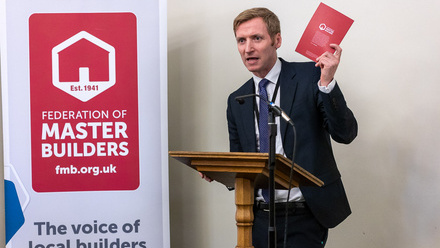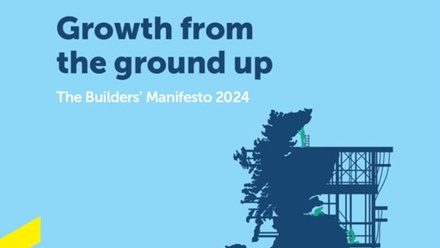Construction is lagging behind in the equality stakes as just 15% of all construction professionals are female* and only 2% on the tools†. Change is slow – this number of women in the industry has crept up by just 4% over the past 10 years. So what barriers are getting in the way, and what can be done to support women with accessing jobs in construction? Here’s how small to medium sized (SME) building companies can play their part in turning the tide.
The short version
Why it matters: In simple terms, employing more women can broaden the pool of available workers and help to plug the skills and labour shortages left by an ageing workforce, all of which can encourage your business to grow. Having more women in senior roles in particular is strongly linked to business profitability, and a policy of diversity and inclusion can be part of SME businesses’ social responsibility – making a change that benefits employees, business owners and broader society as a whole.
The bottom line: Women are woefully underrepresented in the construction industry and face the largest gender pay gap of all sectors – with a 23.7% discrepancy between men and women for the financial year of 2021-22‡.
Many factors play a part, including a lack of flexible working options, a lack of clear paths for career progression, fewer women in senior leadership positions and underwhelming menopause support, as well as an historically male-dominated culture which can be off-putting to women and detrimental to their success in the workplace.
There is also work to be done with educating women and girls about the breadth of career choices within construction and related core subjects from an early age, so it’s seen as viable career choice.
Ensuring your business structure acknowledges and supports the needs of women can help to redress the balance, and SME businesses can lead by example.
* ONS Data for Jul-Sept 2022
†CITB data published in 2019
‡ CIPD gender pay gap reporting for companies with over 250 employees
Why we need to talk about women in construction
It’s clear that the construction industry needs to address why so few women choose building and its associated trades and professions as a career. Part of that conversation involves businesses looking at what they can do to encourage women to apply for roles and examining how they can retain and invest in their skills.
As construction professionals, we know that the industry offers a diverse range of career options – from carpentry to civil engineering. But to many on the outside, construction can still be seen as dirty, labour intensive work requiring physical strength and dominated by the out-dated stereotype of male building site culture. This view needs to be challenged by both businesses and at grassroots level if progress is to be made.
We spoke to our members and senior leaders within the FMB to gain their perspective:

I think there is a misunderstanding that a career in construction mostly involves manual labour, and that’s a view I think that fails to consider the breadth and depth of careers which are available. Whether you are a woman or a man, there really is no better time to join the construction industry. With the UK being in the middle of a housing shortage, young people looking for a long-term future would do really well to look at the building industry for some excellent job security prospects.”

It’s just logical sense for FMB members to recruit from the whole population, not just the 50% of it that is male, when they are looking for the skilled hires they need to develop their businesses. One of the themes that has emerged from the recent FMB Business Coaching programme has been how the shortage of skilled project managers can hold a business back, because without these key people, everything depends on the business owners being very hands on themselves. There is nothing gender-specific about being a good project manager, or indeed about any role in the sector! These days the building industry depends less on physical strength than it did back in the 1970s, and more on talent, resourcefulness and creative problem-solving.”

The industry has failed to shift the dial for decades and that’s not good enough. Think about what construction is missing out on by not being a place where the widest range of people and backgrounds and ideas and experiences can mingle and learn from each other. The creativity and productivity that comes from difference is exciting.”
Much needs to be done to change perceptions, and to both welcome and retain a more diverse workforce. So what are the issues and how can we tackle them?
Why aren't there more women in construction?
A report by leading HR consultants Randstad interviewed 6,000 workers across the construction, education, healthcare and technology sector. The response from the construction sector highlighted where the industry is currently failing women and fostering an environment that is unlikely to attract or retain female workers:
Lack of positive female role models
The study found that 38% of female construction workers had never had a female manager.
No clear career path
49% were unaware of initiatives offered by their company to move female employees into senior or leadership roles.
Male-dominated networking
12% of women in construction felt excluded from work social events – which often clash with caring commitments but where beneficial work relationships and decisions can be made.
Return to work
20% of women in construction reported it would be impossible to return to a senior position after maternity leave – with the key causes being a full-time work culture amongst other directors as well as childcare costs.
Menopause support
80% report a lack of support with menopause for women in construction – where symptoms can lead many to consider leaving work.
What about staff retention?
Randstad also found that tellingly, 21% of women in construction were planning to change jobs within the next 3 months. When asked why, they cited:
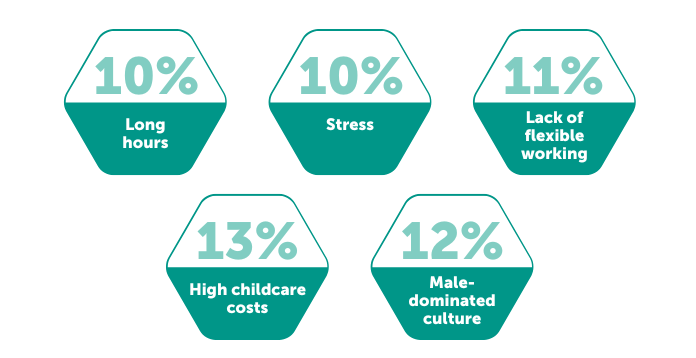
Note that high childcare costs may not seem to be an employer’s responsibility on the face of it, but this can be symptomatic of the inflexible working hours requiring a greater dependence on childcare.
Grassroots education for construction careers

Getting girls into STEM subjects (science, technology, engineering and mathematics) at school can give the future generation of builders the foundation skills they need to access a whole range of construction careers. This includes encouraging girls to think about the real-world applications of construction, engineering and the built environment from an early age. This might include building with Lego and visiting inspiring buildings in primary school, moving on to working out the heat loss of a building and calculating the load on structural beams at GCSE. The message is ‘it’s never too early to start’.
SME businesses can support this though organisations such as CITB, which often arrange for local firms to give careers talks in schools. CITB also offer an abundance of material for young people via its Go Construct website, including myth-busting some of the preconceptions about construction – all of which helps to get girls thinking about careers in the field.
What can SME builders do to get more women into construction?
Arguably, the larger the business, the better placed you are to make a change – as larger firms have the size and capacity to offer structured support for women in the workplace. So, what can smaller construction businesses do to redress the balance and retain female talent with more limited resources?
One of the simplest measures to implement is to promote a work-life balance, to help employees with caring responsibilities (who are more likely to be women). It’s as simple as making sure everyone goes home on time.
You can’t be it if you can’t see it. That’s how the saying goes. And it’s right. I believe strongly that everyone should feel comfortable at work, and feel that they belong. A big part of that is recognising that your workplace is somewhere that welcomes you and respects and celebrates all that makes up who you are. We’ve got a responsibility to make sure that’s the case in construction.”
Let’s take a look at other measures SME businesses can implement to improve the gender balance:
1. Open your doors to flexible working
By considering what flexible working options you might be able to offer your staff, you’ll open up to more applicants for roles, as well as appealing to female applicants – as according to recent findings by the Office for National Statistics, 38% of women work part-time compared to 11% of men.
Women currently in flexible roles are less likely to change job, and because most roles are advertised as full time, and it can be tricky to get an interview if you need a job that fits around caring commitments – be that looking after small children or an elderly relative, caring commitments fall disproportionately to women as shown by this survey by IPSOS and BTIC.
A YouGov survey commissioned by Working Families and SF Recruitment found that 3 in 10 parents in the UK are currently working below their skill level as their current job offers them flexibility. The poll also discovered that 8 out of 10 parents would be more likely to apply for a role that listed flexible working options, while only 3 out of 10 would be likely to apply for a role if it did not list flexible working options.
So it’s clear that by demonstrating you have flexible working options, you will open roles up to more applicants.
The research shows flex is best
Government Equalities Office report on family-friendly working practices (produced by the Institute for Employment Research at University of Warwick in Oct 2019) confirmed that family-friendly policies led to better productivity and overall better economic performance, reduced absenteeism, improved employee recruitment and retention, as well as improved levels of commitment and job satisfaction. They also reported very few examples of negative outcomes for businesses.
Destigmatising flexible working in construction
By making flexible working available to all in your company, you’ll be helping to level the playing field overall. Making it the rule rather than the exception and communicating that it’s open to all can help to de-stigmatise it as a ‘women’s option’ and demonstrate a top-down commitment to its take-up. If you’re looking for resources to help your business with the move to flexible working, Timewise is a social enterprise that offers consultancy, workshops and training to help businesses create a flexible working strategy, and can be a good place to start.
2. Formalise career paths
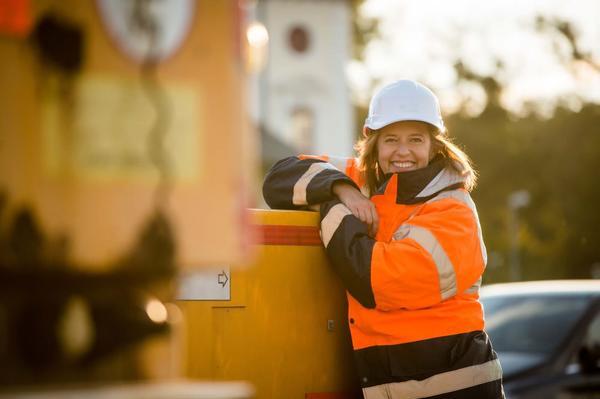
Having more women managers and mentors within your business can help to boost gender diversity at all levels. When it comes to recruiting for these positions, a Government Equalities Office report recommends the following measures to reduce bias:
- Formalising career progression routes within your company and be more transparent about them. Set out clear career paths and offer career planning regardless of the size of your company.
- Be transparent about salaries.
- Introduce fair and objective evaluation when making recruitment and promotion decisions to discourage ‘social cloning’ – which is the ingrained culture of recruiting and promoting people who fit the same demographic as the decision makers.
- Train line managers within your business in the new structure.
It’s worth mentioning that formal unconscious bias training and mentoring groups are often touted as useful tools to help employers build a diverse workplace. However, there’s evidence to suggest that unconscious bias training is not effective in removing gender bias in the workplace, so consider the facts carefully before investing in any online courses or training. The UK Government has stopped investing in this type of training for precisely this reason. Bear in mind that mentoring groups can also be ineffective if they rely on women finding time out of hours to take part in them.
3. Bring your recruitment practices up to date
Randstad recommend removing the unconscious bias in job advertising, which you can do by listing the types of flexible working you can offer from the outset in job advertising, and being up front about your parental leave policy (frequently not disclosed until after the contract is signed).
Research by LinkedIn also shows that women tend to only apply to jobs where they fit 100% of the criteria, compared to men who apply if they meet around 60% - so mentioning any training and development opportunities in your job ad can help to mitigate concerns about not meeting all the criteria and help to balance the number of female applicants.
If it’s possible for you to do so, request blind applications – removing identifying personal data from CVs before they are viewed by the decision maker, including names, age, gender, the names of educational establishments and disabilities.
4. Support women on site
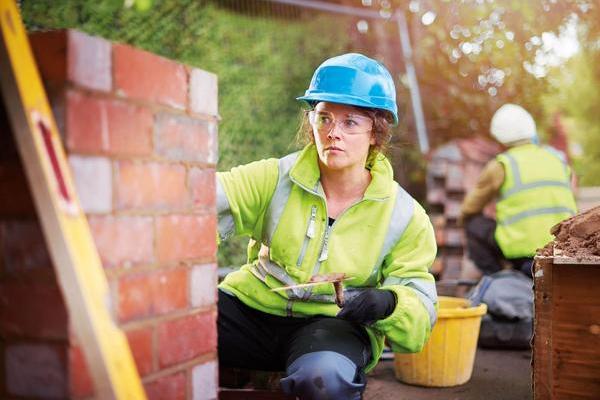
Encouraging a respectful work environment is a positive change all building businesses can make. On a practical level, well-fitting PPE and can be an issue for women on-site, as the standard fit is typically designed for men.
Tools can also be an issue for women and anyone who has a smaller frame – working with kit that’s too heavy or cumbersome can cause strain and repetitive strain injuries (RSI). A standard risk assessment should recommend reviewing the size and weight of items that are handled, and many alternatives are available on the market.
What's the FMB doing to encourage diversity in construction?
There’s huge diversity in the stories our 7,000 member firms have to tell, which is why the FMB makes sure we celebrate and promote a wide range of member voices in our communication and engagement activities. As well as putting a spotlight on members who lead by example, such as through our Building Company of the Year and Heavenly Builder categories at the Master Builder Awards, the FMB is also working across the construction industry to deliver a diversity plan for the built environment.”
Are women becoming more visible in the industry?
The FMB has been in a unique position to see how women have contributed to construction over the past 80 years or so. It’s clear that women have always played a key role in the success of SME construction firms. But their work has often gone unrecognised.
Hayley Lorimer, Director of Membership Services at the FMB explains: ‘20 years ago, when I first joined the FMB, there were already a lot of women playing a vital role in the running of small and medium sized building firms, but they tended to be perceived (by themselves as well as others) as ‘bookkeepers’ or ‘secretaries’. Many of these women were doing a lot more than those job titles implied, such as managing relationships with clients and suppliers, producing contracts, quotations, and dealing with snagging lists and sometimes customer complaints, as well as managing the way the business engaged with its workers, such as dealing with contracts of employment.’
She continues ‘Sometimes these women had taken on these roles as part of the family running a family business, and this tended to mean that their roles were not clearly defined, and they were often juggling family responsibilities as well.’
At the FMB, we now see more women coming to the fore. ‘It does seem as though women working in our members’ businesses now are more recognised for the valuable role they play,’ said Hayley. ‘Often these women bring experience from other industries which can be really helpful to the business in taking it to the next level. Marketing or legal expertise for example can help to transform a business, as can organisational and communications skills, transferrable from many different roles. Women working ‘on the tools’ on site, have always been something of a rarity, and changes there are emerging very slowly.’
What support is available from the FMB?

Hayley advises: ‘FMB members who would like to think about their businesses ‘DNA’ – the invisible culture that permeates the way they work, and the way they interact with clients and workers – may want to take a look at a couple of the FMB’s free e-learning modules, for example the modules on ‘Recruitment and Selection’ or ‘Respect in the Workplace’ could be useful. It is not an easy thing to change a workplace culture, but that starts with the business owners, Directors and managers thinking about how they can make their business more welcoming and attractive to diverse groups.’
‘The e-learning modules only take half an hour to follow, good for a coffee-break and a ponder! Members also have access to a free one-to-one HR service to review their practices. If tailored support is then needed then that service is chargeable, but at reasonable rates which you will be quoted before you embark upon it. It’s well worth taking time for this if your business has grown and you are employing more people, male or female!’
Both the HR one to one service and e-learning can be accessed via the members area of the FMB website.




